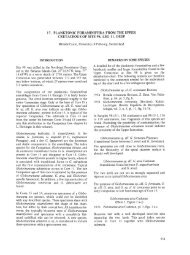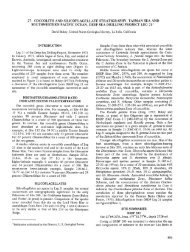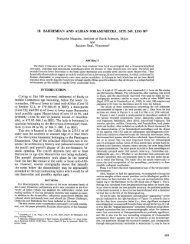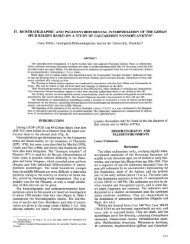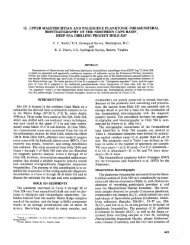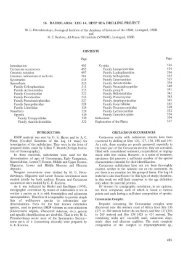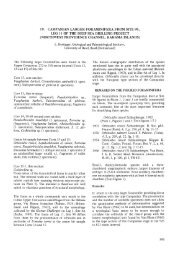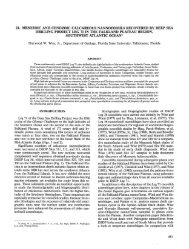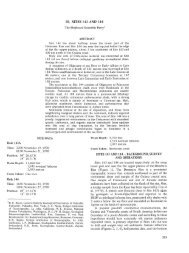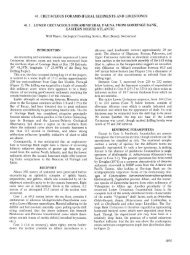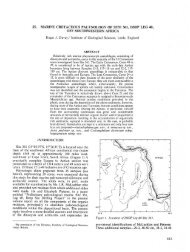1 - Deep Sea Drilling Project
1 - Deep Sea Drilling Project
1 - Deep Sea Drilling Project
Create successful ePaper yourself
Turn your PDF publications into a flip-book with our unique Google optimized e-Paper software.
Distephanus boUviensis Zone<br />
This zone is characterized by the common presence of<br />
the large, distinctive species, Distephanus boUviensis. Dictyocha<br />
fibula is dominant; other meager to rare but consistently<br />
present species include Distephanus<br />
quinquangellus, D. speculum, and Dictyocha aspera. The<br />
top of the zone is indicated by the last common Distephanus<br />
boUviensis and by the first common occurrence of<br />
post-Miocene Mesocena elliptica. The base of the zone is<br />
indicated by the highest consistent occurrences of Cannopilus<br />
sp. and Distephanus minutus and by a general<br />
increase in the abundance of D. boUviensis. Cores 11 to 17<br />
of DSDP 157 provide a reference section.<br />
Cannopilus major Zone<br />
This zone is characterized by the consistent presence of<br />
species of Cannopilus, with C. major most prominent.<br />
Dictyocha fibula is dominant, and D. aspera, Distephanus<br />
boUviensis, D. minutus, D. speculum, and Mesocena circula<br />
are present in lesser numbers. The top of the zone is<br />
marked by the last consistent occurrence of Cannopilus,<br />
and the base by the first consistent occurrence of both<br />
Distephanus boUviensis s.s. and Cannopilus.<br />
The upper Pliocene occurrence of Cannopilus in the<br />
tropical Pacific Ocean was indicated by Jousé (1969). Owing<br />
to their large size, subdivided apical rings, and limited<br />
stratigraphic range in the eastern tropical Pacific, these<br />
forms provide excellent zonal markers. Cores 18 to 26 at<br />
DSDP 157 are a reference section for the zone.<br />
Distephanus crux Zone<br />
This zone is characterized by the consistent presence of<br />
Distephanus crux, D. minutus, D. speculum, Dictyocha<br />
aspera, and D. fibula. Other species present sporadically<br />
through the zone are Dictyocha navicula, Distephanus<br />
boUviensis s. 1., D. polyactis, and D. quinquangellus. The<br />
top of the zone is indicated by the first occurrence of the<br />
Cannopilus major group, the first consistent D. boUviensis<br />
s.s., and by the last consistent occurrence of D. crux. The<br />
base of the zone is indicated by the last common occurrence<br />
of Distephanus longispinus or D. sp. cf. D. longispinus,<br />
which approximates the earliest occurrence of D.<br />
quinquangellus. This long zone can be subdivided into an<br />
upper Dictyocha fibula Subzone and a lower Dictyocha<br />
aspera Subzone on the basis of relative abundances. In the<br />
upper subzone, D. fibula is usually more abundant than<br />
D. aspera, and D. navicula is more abundant than below.<br />
In the lower subzone, D. aspera is typically more abundant<br />
than D. fibula. Also, Mesocena diodon and Miocene<br />
Mesocena elliptica are more numerous than above.<br />
Mesocena diodon is apparently restricted to the lower subzone.<br />
The chronostratigraphic value of these subzones is<br />
limited, as the reversal in dominance between D. aspera<br />
and D. fibula occurs in the upper Discoaster quinqueramus<br />
Zone of coccoliths at DSDP 157 and in the upper Discoaster<br />
neohamatus Zone of coccoliths at DSDP 158.<br />
Cores 10 to 24 at DSDP 158 and Cores 27 to 38 at DSDP<br />
157 provide reference sections for the Distephanus crux<br />
Zone.<br />
SILICOFLAGELLATE AND DIATOM STRATIGRAPHY<br />
Corbisema triacantha Zone<br />
This zone is characterized by the consistent meager to<br />
common occurrence of Corbisema triacantha in conjunction<br />
with abundant Dictyocha aspera and meager to common<br />
D. fibula, D. medusa, Distephanus crux, D.<br />
longispinus s. 1., and D. speculum. The top of the zone is<br />
marked by the last consistent occurrence of C triacantha<br />
in the presence of D. longispinus s. 1. All higher occurrences<br />
are rare and sporadic, with D. longispinus missing.<br />
The base of the zone is indicated by the last consistent<br />
occurrences of two distinctive eight-spined species, Dictyocha<br />
octagona and Distephanus octacanthus. This zone<br />
was described by Martini (1971) in cores from the central<br />
equatorial Pacific that were assigned to the lower(?) to<br />
middle Miocene. The occurrence of this zone within the<br />
middle Miocene Discoaster exilis Zone of coccoliths at the<br />
base of the Leg 16 Panama Basin section and at the Experimental<br />
Mohole section supports this assignment.<br />
Distephanus octacantha Zone<br />
This zone is characterized by the abundant occurrence<br />
of Distephanus octacanthusand Dictyocha octagona. Other<br />
members of the assemblage include Corbisema triacantha,<br />
Dictyocha aspera, D. fibula, and Distephanus crux. This<br />
zone is distinguished from the overlying Corbisema triacantha<br />
Zone by the dominance of both D. octacanthus and<br />
D. octagona over C. triacantha and by the lack of Distephanus<br />
longispinus. The top of the zone is distinguished by<br />
the last common occurrence of D. octacanthus and D.<br />
octagona and by the earliest local occurrence of D. longispinus.<br />
Because this unit has been seen only at the base of<br />
the Experimental Mohole section, the base of the zone is<br />
unknown.<br />
Taxonomic Usage<br />
In the past, a combination of trinomial and even quàdrinomial<br />
systematics with a repetitive use of the same or<br />
similar names has made silicoflagellate taxonomy and<br />
recombinations difficult. In the system of taxonomy presented<br />
in this report, binomial usage is preferred.<br />
Only six genera are used in this report. Cannopilus<br />
includes all forms with subdivided apical rings. Corbisema<br />
includes all forms with triangular body rings and simple,<br />
three-strut central structures. Dictyocha includes all other<br />
forms with simple strut structures or struts with an apical<br />
bar. Distephanus includes all forms with an open apical<br />
ring. Mesocena includes all forms possessing only a body<br />
ring with no central structures. Octactis, possibly a special<br />
octasymmetric form of Distephanus, has only a vestigial<br />
apical structure.<br />
SILICOFLAGELLATE SYSTEMATIC PALEONTOLOGY<br />
Specific literature references to all silicoflagellate tax a published<br />
through 1967 have been indexed by Loeblich et al., 1968. The<br />
sources of silicoflagellate taxonomy are given fully in that work,<br />
therefore full synonymies are not given here.<br />
Genus CANNOPILUS Haeckel, 1887<br />
Cannopilus binoculus (Ehrenberg) Lemmermann, 1901<br />
(Plate 1, Figures 1-2)<br />
Remarks: This species is characterized by a large apical ring that is<br />
symmetrically divided by a bar into two openings. The basal ring is<br />
825



